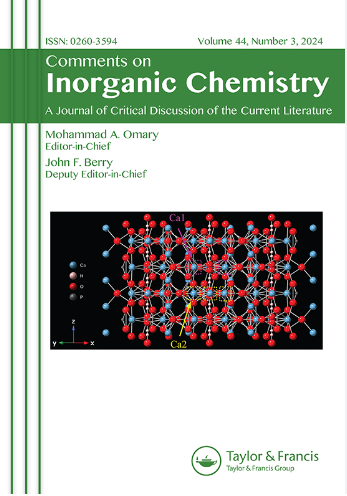On the Possibility of Synthesizing Bimno3 at Ambient Pressure Using Low-Temperature Methods
IF 3.8
3区 化学
Q1 CHEMISTRY, INORGANIC & NUCLEAR
引用次数: 5
Abstract
BiMnO3 exhibit multiferroic properties, which attract much attention due to numerous potential applications. The most well-investigated and traditional techniques for synthesizing this material include high-pressure and high-temperature treatment. In this way, soft chemistry synthesis of BiMnO3 is desirable. Even though the formation of BiMnO3 at ambient pressure is not possible according to the phase diagram, many scientific groups are focused on solving this problem. In the present work, we have tested four soft chemistry routes, namely hydrothermal route, two gel methods, and coprecipitation for synthesizing BiMnO3 from Cl– and NO3–-containing solutions at ambient pressure in the temperature range of 200–800°C, and none resulted in the formation of BiMnO3. The experiment showed that under hydrothermal conditions manganese and bismuth oxides remain unreacted, and the other tested methods produce Bi2Mn4O10 and Bi12MnO20 instead. The formation of Bi2Mn4O10 and Bi12MnO20 from Cl–-containing solutions occurs with BiOCl being formed as an intermediate phase. Graphical Abstract常温下低温法合成Bimno3的可能性研究
BiMnO3具有多铁性,具有广泛的应用前景。研究最充分和传统的合成这种材料的技术包括高压和高温处理。在这种情况下,软化学合成BiMnO3是可取的。尽管根据相图,在环境压力下形成BiMnO3是不可能的,但许多科学团体都致力于解决这个问题。在本工作中,我们测试了四种软化学途径,即水热法、两种凝胶法和共沉淀法,在环境压力下,在200-800℃的温度范围内,从含Cl -和NO3 -的溶液中合成BiMnO3,均未形成BiMnO3。实验表明,在水热条件下,锰和铋氧化物不发生反应,而其他测试方法则生成Bi2Mn4O10和Bi12MnO20。Bi2Mn4O10和Bi12MnO20由含Cl的溶液形成,BiOCl作为中间相形成。图形抽象
本文章由计算机程序翻译,如有差异,请以英文原文为准。
求助全文
约1分钟内获得全文
求助全文
来源期刊

Comments on Inorganic Chemistry
化学-无机化学与核化学
CiteScore
9.00
自引率
1.90%
发文量
18
审稿时长
>12 weeks
期刊介绍:
Comments on Inorganic Chemistry is intended as a vehicle for authoritatively written critical discussions of inorganic chemistry research. We publish focused articles of any length that critique or comment upon new concepts, or which introduce new interpretations or developments of long-standing concepts. “Comments” may contain critical discussions of previously published work, or original research that critiques existing concepts or introduces novel concepts.
Through the medium of “comments,” the Editors encourage authors in any area of inorganic chemistry - synthesis, structure, spectroscopy, kinetics and mechanisms, theory - to write about their interests in a manner that is both personal and pedagogical. Comments is an excellent platform for younger inorganic chemists whose research is not yet widely known to describe their work, and add to the spectrum of Comments’ author profiles, which includes many well-established inorganic chemists.
 求助内容:
求助内容: 应助结果提醒方式:
应助结果提醒方式:


